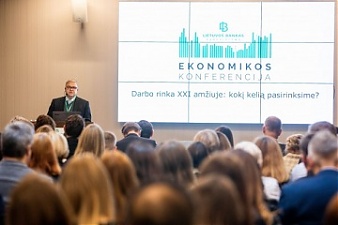Analytics, Banks, Direct Speech, Economics, Financial Services, Labour-market, Lithuania
International Internet Magazine. Baltic States news & analytics
Friday, 09.05.2025, 12:32
Welcome remarks by Vytautas Vasiliauskas at the Economics conference Labour Market in the 21st Century:The Way Forward
 Print version
Print version |
|---|
This marks our third annual economics conference. The first
one tackled income inequality. Last year, we brainstormed on how to create a
sustainable pension system that would seem trustworthy not only to its
creators, but also to the people of Lithuania.
It is obvious that we do not steer clear of difficult
topics. Quite the opposite – we are creating a meaningful tradition of
gathering every year to deliberate on the fundamentals: urgent issues that pose
high risks. In other words, we are taking the initiative to seek measures that
could solve – or at least facilitate solving – key problems. Especially those
that demand a systematic approach.
This is precisely why we have invited you to discuss the
labour market this year. We consider labour market dynamics an alarming issue.
Labour market developments are among the strongest factors – and possibly the
strongest one – contributing to where we will find ourselves in 50, 20 or even
10 years. What do I mean exactly?
According to Eurostat data and taking into account
differences in prices, before the crisis Lithuania’s GDP per capita amounted to
a meagre 60% of the EU average. Today, we have reached more than 80% of the
Community’s average. Of course, GDP per capita is not a perfect indicator of
well-being. Nonetheless, we cannot deny it – convergence is progressing. With
household income growing at a faster rate than the overall price level, this
process is felt by an increasingly larger fraction of society. And this is the
good news.
However, there is also bad news. This is how I would
describe it: convergence will not be sustainable nor long-lasting if we do not
overcome the growing challenges of the labour market. We have seen instances in
the EU when convergence among countries stalls. Or, even worse, when countries
start moving backwards instead of forwards. The main hindrences in such
economies are often found in their labour markets.
Colleagues,
I do not wish to sound overly pessimistic. If we did not
believe that we still have the time and the skills to identify the correct
solutions, we would not have invited you to this discussion. Therefore, I am
going to name three issues that I deem of utmost importance when considering
economic policy proposals today. These are: demographics, technological
progress and regional disparities.
Let us take the first item, demographics. In the past 20
years, the working-age population in Lithuania has shrunk by almost a quarter.
Today, there are around 1.8 million working-age individuals. If no significant
changes occur, there will be fewer than 1.5 million working-age people in 2030,
and just over a million in 20601.
It is important to
note here that this year we will be able to mark the net migration rate in
green rather than red, meaning that more people are coming to Lithuania than
leaving it. Therefore, the total population should increase – for the first
time since 1992.
Let’s not deceive
ourselves, though. One year is not enough to claim a sustainable trend.
Additionally, immigration (at least at the current pace) is
not going to be a demographic magic bullet. The decrease of working-age
population is going to continue in Lithuania as the ageing of the population
will outweigh the positive impact of immigration.
Under these circumstances, some employers, especially in
certain sectors, are already forced to compete for every single employee by
increasing wages. This is good news for workers. However, with wages growing
faster than efficiency, in the long term we are risking a loss of
competitiveness and the positions that we have fought for in foreign
markets.
And that would be
terrible news for everybody. Hence, it is likely that our country’s employers,
seeking to avoid that turn of events, will pursue ways to adapt to the
decreasing number of employees other than offering larger wages.
Research shows that human-performed task automation is
likely to happen more swiftly in countries faced with demographic challenges2.
As such, there is an imperative to discuss the challenges and
possibilities of technological progress.
According to the OECD
calculations3, medium risk of job automation in Lithuania amounts to more than
50%. This means that a person could be replaced by a robot in every second
current workplace.
There would certainly be losers in this situation: those who
are swept away by the wave of progress and find themselves in a worse position
than the one they began in. This would place an additional burden on the social
security system.
But how many winners would this bring? Those who have new
jobs created by the technological progress? Are we ready to reap the rewards of
the fourth industrial revolution – to successfully apply big data, artificial
intelligence, nanotechnology?
To prepare ourselves for that, we are going to need highly
qualified workers. Yet, there is already a shortage of them even today. In
Lithuania, around a third of the population falls into a qualification mismatch
category, meaning that their skills do not match labour market demands.
Let us not forget that the negative effects of technological
development are geographically imbalanced. Less urbanised locations will
probably face faster development of automation due to the prevailing type of
work there. These ongoing processes may further increase labour market
inequality between Lithuania’s regions.
This leads us to the third challenge we are going to delve
into today: regional disparity.
It is already evident
that more and more jobs are being created in large cities rather than in
peripheral areas. Up until the crisis of 2008, the unemployment rate in big
cities matched the rate in the more remote regions. After the crisis, profound
differences came to the fore: the average unemployment rate in such regions is
double the size of that in cities.
Changes in Lithuania’s economic structure shrunk the
importance of the agricultural sector and amplified that of the service sector.
Clearly, regions find it difficult to adapt to these structural changes. What
we have there now is structural unemployment – something that cannot be reduced
even by the fast overall expansion of the country’s economy.
We are also witnessing the consequences of persistent
unemployment. People are leaving smaller cities. Birth and mortality rates are
quite similar throughout the counties in Lithuania, but migration rates differ
significantly. Over the last 20 years, the number of young age workers in our
country’s regions has shrunk by a half, except for the three biggest
cities.
Colleagues,
I have just set forth three problems that we consider
paramount. How are we to solve them? We have no crystal ball to turn to for
answers. We can turn to each other, though. We have gathered here to try to
arrive at possible ways of overcoming these challenges by means of
discussion and search for best international practises.
Each of the challenges I have identified is quite distinct
from the others. Together, however, they are so closely connected that at first
sight it is hard to tell cause and consequence apart. It is like the proverbial
chicken-and-egg. Clearly, then, in order to achieve real results, we must act
on several fronts at once while bearing in mind the big picture.
Firstly, we have to create regulatory labour market
instruments that combine employer flexibility and safety of the employee.
Moreover, such instruments should stimulate more active participation of
different population groups in the labour market. I am thus thrilled that the
keynote speech will shortly be delivered by Professor Werner Eichhorst,
one of the most prominent experts of labour market regulation policy in Europe.
It is also obvious that Lithuania is in desperate need of
long-term and far-sighted migration policy to both entice emigrants to return
home and attract foreign workers.
What is more, when discussing quantity, we should not forget
quality, especially if we seek to prepare ourselves for technological changes
and the impending fourth industrial revolution.
What skills will be most in demand? No one knows. And anyone
who thinks they do are probably mistaken. As the astronaut Buzz Aldrin
once said, ‘You promised me colonies on Mars. And instead, I got... Facebook’.
I take this to mean that we can only guess what the future has in store for us.
Which is why we have to move towards an educational system that is flexible and
oriented towards lifelong learning, both formal and informal, including adult
education and effective retraining. Such a system is the only way to prepare
our people for rapid structural change.
Lastly, we need a real regional policy – one that is
effective and adequate for the current situation. One that would not only help
maintain economic life throughout Lithuania, but would also prompt a shift
towards higher value-added economic activities.
Undoubtedly, education should have an especially important
place in this policy in order to ensure equally good quality of education to
all children in all parts of the country. In Lithuania, schoolchildren in
cities are ahead of their peers in rural areas by one year in assessment of
their mathematics skills. This difference is two times larger than the average
for the developed countries4.
Hence, we are not providing equal opportunities for young
people to graduate from school, obtain high-level qualifications and find a
well-paid job. And this is an especially unfair form of inequality of
opportunities. It creates a vicious cycle: the number of jobs that ensure
dignified income in rural regions is not increasing, at least not at a rate
that we would like. Yet, with the lack of a qualified labour force, investors
who create high added-value are not coming to these regions – so they are not
creating such work places.
Dear
Colleagues,
As I have mentioned, we have chosen the topic of the labour
market for this conference because we consider it one of today’s most burning
issues. Additionally, we chose it because economists’ projections,
unfortunately, show the worst-case scenarios as the more likely ones. But the
main reason is that we can still adjust those scenarios so that the curves go
upwards rather than downwards.
I am aware that we
will neither make nor implement decisions today. Yet, seeing such a
professional, engaged and competent group of participants, I am confident that
we can stimulate a positive turn.
That is my hope for all of us here.
I thank you for your time, and wish you fruitful discussions.
*** 1 Eurostat
projections.
2 E.g. Abeliansky A.,
Prettner K. 2017; Acemoglu D., Restrepo P. 2018.
3 Nedelkoska L., Quintini G. 2018.
4 OECD 2017, Education in Lithuania, Reviews of National
Policies for Education, OECD Publishing, Paris. Economic analysis and
projections, International relations








 «The Baltic Course» Is Sold and Stays in Business!
«The Baltic Course» Is Sold and Stays in Business!

